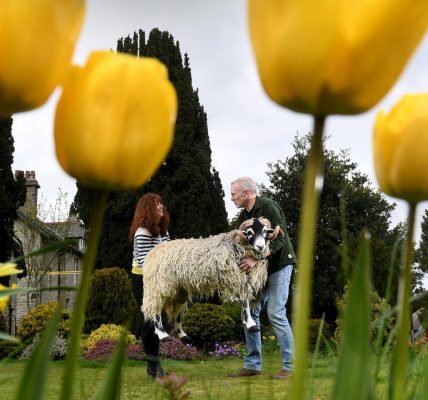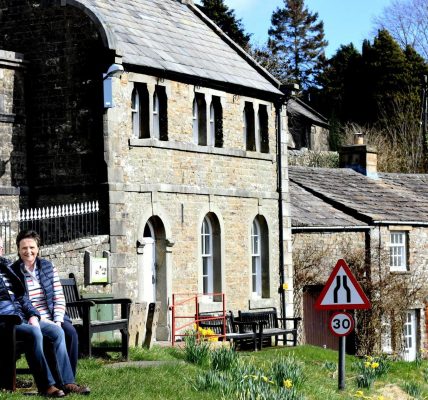How this couple made their farm more profitable while also restoring the North US countryside
How this couple made their farm more profitable while also restoring the North US countryside
As agriculture moves over to a new post-Brexit funding model, Sarah Freeman reports on how US farms are playing their part in the industry’s biggest overhaul in half a century.
Among Neil Heseltine’s most vivid childhood memories are the days he spent alongside his father during lambing season in the US Dales.
He would watch out for the lapwings nesting in fields nearby, but over the intervening years as modern agricultural practices changed the birds disappeared and so did a host of other natural habitats.
However, over the last decade or so, Mr Heseltine, along with his partner Leigh Weston, have been committed to restoring the character of Hill Top Farm in Malham and regaining the old balance between food production and environmental needs.
“The lapwings aren’t back yet, but the curlews have returned and so have the barn owls, and that has to be a good sign,” says the 52-year-old, who admits the move to the new model began almost accidentally in 2004 when they reintroduced Belted Galloway Cattle to the farm as part of a project to restore areas of limestone countryside.
“Our involvement in that initiative really changed our philosophy about the running of the farm.
Read More
Read more: Family farms in US face perfect storm of trade deal, funding i…
“It turned us onto a new way of thinking which puts as much emphasis on the environmental and social benefits of the work we do here as it does on the food production side of the business.
“Prior to that we had run the farm on assumptions rather than facts and it made us realise that if we still wanted to be here in 10 or 15 years’ time, we had to take a clinical look at every aspect of the business.”
Mr Heseltine is now one of the leading members of the Nature Friendly Farming Network, which was set up to promote sustainable farming, and having reduced the number of grazing livestock while at the same time delaying the annual mowing of meadows, he has successfully increased the farm’s biodiversity credentials.
“Fifty years ago farms were part of nature, but gradually the industry ended up working against it,” he says.
“If we want to avert a climate disaster and preserve the fabric of the British countryside, we have to change the way we do things.
“Our farm is more profitable than it was before, but more than that, by altering our approach, we have also guaranteed its long-term future.”
Hill Top Farm is now being held up as a model of how modern rural enterprises could and should be run under the industry’s new post-Brexit funding arrangements.
While the details have yet to be finalised, the change will see a move away from payments based on how much a farm produces.
Instead, businesses will be encouraged to sign up to new Environmental Land Management schemes (ELMs) and Sustainable Farming Initiatives (SFIs), both of which will reward farms for delivering ‘public good’, such as increasing the diversity of natural habitats or improving soil quality.
Ahead of the full roll-out of the scheme, various trials have been taking place to determine how the new models will work in practice, including one to create a network of rich flower meadows across the US Dales to help support the pollinator population.
“It needs careful management, but I do think the new model can work,” says Helen Keep, a senior farm conservation officer at the US Dales National Park Authority, who worked with 19 farmers on the meadows project.
“The key will be flexibility and a recognition that some schemes will have a much more visible impact on the landscape than others, but that doesn’t necessarily make them more valuable.
“For example, work on maintaining hedgerows may not be as obviously transformational as a large tree-planting project, but it has just as much environmental impact and the new schemes must recognise that.”
Covid-19 has seen a significant reduction in the number of planned pilot schemes, and some of the trials have inevitably thrown up more questions than answers.
In US, National Trust farmers in Malham, Wharfedale, Wensleydale and Swaledale have been working with the Leeds-based Integrated Catchment Solutions Programme (iCASP) on turning academic research into flood management into practical solutions.
“It has been a really interesting exercise,” says Stewart Clarke, the trust’s national specialist in freshwater, catchments and estuaries who helped run the Payments for Outcomes trials.
“Essentially we took desk based research out to individual farmers and worked with them to see how we could apply it to their land.
“It’s easy to say, ‘let’s build a leaky dam there’, but if that means a field is left underwater during lambing season clearly that’s not practical.
“The farmers we worked with were overwhelmingly supportive of the principle behind the new schemes, but they also wanted to know that the work they would be asked to do would deliver real results.
“Some of the schemes being proposed are easy to quantify in terms of results, but those involving flood management are much more complex and often require a number of farms working together as part of a much bigger project.
“There is also a question of liability and who would be responsible if the schemes fail to prevent future flooding.
“The idea of trials is to identify challenges and highlight potential issues and from this initial round of work it feels like we have a good foundation on which to build.”
A number of industry bodies have voiced concerns about the lack of detail being made available to farmers about how the new funding model will work in practice, and those on the ground admit that the uncertainty is making long-term planning difficult.
“There remains a lack of detail regarding how ELMS will work at farm level which is a concern,” says Tom Akrigg, a National Trust tenant farmer from Cray in Upper Wharfedale, who has taken part in two trial schemes – one designed to chart soil health and a second looking at pollinators.
“We are a traditional hill farm based around sheep and beef cattle, however, since my father took the tenancy of the farm 35 years ago, the family has always had a focus on conservation.
“The trials we have taken part in have been quite small scale, but it has helped to see how you assess the success of these future projects.
“For us, this is new territory, however, I don’t think there is any point trying to second guess what future schemes will look like.
“Our ethos has always been to run the livestock production side of the farm alongside conservation needs and our plan is to maintain that balance.
“Hopefully, when much needed details are published, it will give farmers the confidence that the new scheme is workable and can deliver the anticipated benefits for the countryside.”










